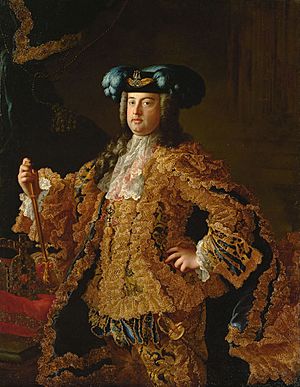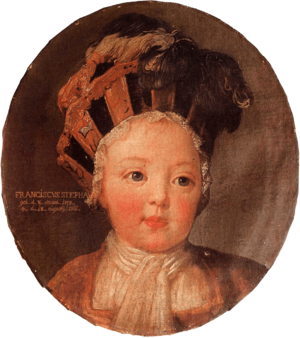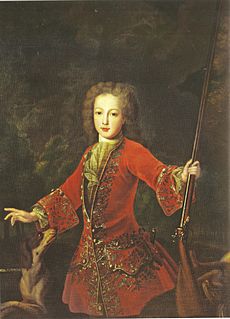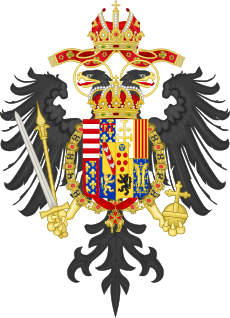Francis I, Holy Roman Emperor facts for kids
Quick facts for kids Francis I |
|||||
|---|---|---|---|---|---|

Portrait by Martin van Meytens, c. 1745
|
|||||
| Holy Roman Emperor | |||||
| Reign | 13 September 1745 – 18 August 1765 | ||||
| Proclamation | 4 October 1745, Frankfurt | ||||
| Predecessor | Charles VII | ||||
| Successor | Joseph II | ||||
| Grand Duke of Tuscany | |||||
| Reign | 12 July 1737 – 18 August 1765 | ||||
| Predecessor | Gian Gastone | ||||
| Successor | Leopold I | ||||
| Duke of Lorraine and Bar | |||||
| Reign | 27 March 1729 – 9 July 1737 | ||||
| Predecessor | Leopold | ||||
| Successor | Stanislas | ||||
| Born | 8 December 1708 Ducal Palace of Nancy, Lorraine, Holy Roman Empire |
||||
| Died | 18 August 1765 (aged 56) Palace of Innsbruck, Austria |
||||
| Burial | Imperial Crypt | ||||
| Spouse | |||||
| Issue |
|
||||
|
|||||
| House | Lorraine | ||||
| Father | Leopold, Duke of Lorraine | ||||
| Mother | Élisabeth Charlotte d'Orléans | ||||
| Religion | Catholicism | ||||
| Signature | |||||
Francis I (born Francis Stephen; 8 December 1708 – 18 August 1765) was an important ruler in Europe. He was the Holy Roman Emperor, the Archduke of Austria, the Duke of Lorraine and Bar, and the Grand Duke of Tuscany.
He became a powerful ruler through his marriage to Maria Theresa. She was the daughter of Emperor Charles VI. Francis was the last emperor who was not from the Habsburg family. However, his wife, Maria Theresa, mostly governed their lands. Together, they started the Habsburg-Lorraine family line. They had sixteen children.
Francis was the fourth son of Leopold, Duke of Lorraine, and Princess Élisabeth Charlotte d'Orléans from France. When his father died in 1729, Francis became the Duke of Lorraine. In 1736, he married Maria Theresa. He later gave up Lorraine for the Grand Duchy of Tuscany. This was part of a peace deal after the War of the Polish Succession. After his father-in-law, Charles VI, died in 1740, Francis and Maria Theresa became rulers of the Habsburg lands. Francis was very good with money. He managed the empire's finances well. He died in 1765. His son, Joseph II, then ruled Austria with Maria Theresa.
Contents
Early Life and Family
Francis was born in Nancy, a city in Lorraine. This area is now part of France. He was the oldest son of Leopold, Duke of Lorraine. His mother was Princess Élisabeth Charlotte d'Orléans. Francis was related to the Habsburg family through his grandmother. He was very close to his brother Charles and his sister Anne Charlotte.
Emperor Charles VI liked Francis's family. They were his cousins and had served Austria well. The Emperor had planned for his daughter, Maria Theresa, to marry Francis's older brother. But when his brother died, Charles chose Francis instead. Francis grew up in Vienna with Maria Theresa. They knew they would marry and developed a real affection for each other.
When Francis was 15, he moved to Vienna. He was given the Silesian Duchy of Teschen by the Emperor. In 1729, Francis became the Duke of Lorraine after his father's death. In 1731, he joined the Freemasons.
Maria Theresa wanted Francis to be closer to her. So, in 1732, she arranged for him to become "Lord Lieutenant" of Hungary. This meant he would represent the ruler there. Francis was not very keen on this job. But in June 1732, he agreed to go to Pressburg, the capital of Hungary.
Changes in Power
In 1733, the War of the Polish Succession began. France used this war to take control of Lorraine. France's prime minister, Cardinal Fleury, worried that Lorraine, being close to France, would make Austria too powerful.
A peace agreement was made in 1735. It was officially signed in the Treaty of Vienna in 1738. Under this treaty, Stanisław I, the father-in-law of King Louis XV, received Lorraine. Francis, in return, was promised the Grand Duchy of Tuscany. He would inherit it in 1737.
The fighting stopped after the first peace deal. But the final agreement had to wait. It waited until the last ruler of Tuscany, Gian Gastone de' Medici, died in 1737. This allowed the land exchanges to happen.
In March 1736, the Emperor convinced Francis to secretly trade Lorraine for Tuscany. France had insisted that Maria Theresa's future husband give up his family's Duchy of Lorraine. This was to make a place for the former King of Poland. The Emperor thought about other options for Maria Theresa's marriage. But then he announced her engagement to Francis.
Marriage and New Titles
Francis and Maria Theresa married on 12 February 1736, in Vienna. A secret treaty between Francis and the Emperor was signed in May 1736. In January 1737, Spain gave up Parma, Piacenza, and Tuscany to the Holy Roman Empire. The Empire, in turn, recognized Don Carlos of Spain as King of Naples and Sicily.
Spanish troops left Tuscany, and Austrian troops took their place. On 24 January 1737, Francis officially received Tuscany from his father-in-law. Before this, Maria Theresa was the Duchess of Lorraine.
Gian Gastone de' Medici, Grand Duke of Tuscany, who died on 9 July 1737, was Francis's second cousin. In June 1737, Francis went to Hungary again to fight against the Turks. By October 1738, he was back in Vienna. In December 1738, Francis and Maria Theresa traveled to Florence for three months. They arrived on 20 January 1739.
In 1744, Francis's brother Charles married Maria Theresa's younger sister, Archduchess Maria Anna. Charles became governor of the Austrian Netherlands in 1744. He held this position until his death in 1780.
Ruling as Emperor
In the Treaty of Füssen, Maria Theresa made sure Francis was elected Emperor. This happened on 13 September 1745. He took over from Charles VII. Maria Theresa also made him a co-ruler of her own lands.
Francis was happy to let his capable wife, Maria Theresa, handle most of the power. He had good common sense and was very good with business. He helped Maria Theresa greatly in managing the complex Austrian lands. However, he was not very active in politics or diplomacy.
His wife trusted him with all financial matters. He managed these very well until he died. After the Seven Years' War, the Austrian Empire was heavily in debt. But thanks to Francis, its financial situation was better than France or Great Britain in the 1780s. He was also very interested in science.
Francis died suddenly in his carriage on 18 August 1765. He was returning from the opera in Innsbruck. He is buried in tomb number 55 in the Imperial Crypt in Vienna.
Maria Theresa and Francis I had sixteen children. Their youngest daughter, Marie Antoinette (1755–1793), later became the Queen of France. Francis's oldest son, Joseph II, became Emperor after him. His younger son, Peter Leopold, became Grand Duke of Tuscany. Maria Theresa continued to rule her lands until her death in 1780.
Children of Francis I
| № | Name | Birth | Death | Notes |
|---|---|---|---|---|
| 1 | Archduchess Maria Elisabeth of Austria | 5 February 1737 | 7 June 1740 | died in childhood, no issue |
| 2 | Archduchess Maria Anna | 6 October 1738 | 19 November 1789 | died unmarried, no issue |
| 3 | Archduchess Maria Carolina of Austria | 12 January 1740 | 25 January 1741 | died in childhood likely from smallpox, no issue |
| 4 | Holy Roman Emperor Joseph II | 13 March 1741 | 20 February 1790 | married 1) Princess Isabella Maria of Parma (1741–1763), married 2) Princess Marie Josephe of Bavaria (1739–1767) – second cousin, had issue from his first marriage (two daughters, who died young) |
| 5 | Archduchess Maria Christina of Austria | 13 May 1742 | 24 June 1798 | married Prince Albert of Saxony, Duke of Teschen (1738–1822), her second cousin, had issue (one stillborn daughter) |
| 6 | Archduchess Maria Elisabeth of Austria | 13 August 1743 | 22 September 1808 | died unmarried, no issue |
| 7 | Archduke Charles Joseph of Austria | 1 February 1745 | 18 January 1761 | died of smallpox, no issue |
| 8 | Archduchess Maria Amalia of Austria | 26 February 1746 | 9 June 1804 | married Ferdinand, Duke of Parma (1751–1802), had issue. |
| 9 | Holy Roman Emperor Leopold II | 5 May 1747 | 1 March 1792 | married Infanta Maria Luisa of Spain (1745–1792), had issue. Grand Duke of Tuscany from 1765 (abdicated 1790), Holy Roman Emperor from 1790, Archduke of Austria, King of Hungary and King of Bohemia from 1790. |
| 10 | Archduchess Maria Carolina of Austria | 17 September 1748 | 17 September 1748 | died during birth. |
| 11 | Archduchess Maria Johanna Gabriela of Austria | 4 February 1750 | 23 December 1762 | died of smallpox, no issue |
| 12 | Archduchess Maria Josepha of Austria | 19 March 1751 | 15 October 1767 | died of smallpox, no issue |
| 13 | Archduchess Maria Carolina of Austria | 13 August 1752 | 7 September 1814 | married King Ferdinand IV of Naples and Sicily (1751–1825); had issue |
| 14 | Archduke Ferdinand of Austria | 1 June 1754 | 24 December 1806 | married Maria Beatrice d'Este, Duchess of Massa, heiress of Breisgau and of Modena, had issue (Austria-Este). Duke of Breisgau from 1803. |
| 15 | Archduchess Maria Antonia of Austria | 2 November 1755 | 16 October 1793 | married Louis XVI of France and Navarre (1754–1793) and became Marie Antoinette, Queen of France and Navarre. |
| 16 | Archduke Maximilian Franz of Austria | 8 December 1756 | 27 July 1801 | Archbishop-Elector of Cologne, 1784. |
Images for kids
-
Silver coin: 10 paoli Grand Duchy of Tuscany - Francis, 1747
-
Silver coin: 1 conventionsthaler Augsburg Free City - Francis I, 1765
See also
 In Spanish: Francisco I del Sacro Imperio Romano Germánico para niños
In Spanish: Francisco I del Sacro Imperio Romano Germánico para niños
- Franz Joseph Toussaint
- Kings of Germany family tree
- List of people with the most children
- Francis Stephen Award







